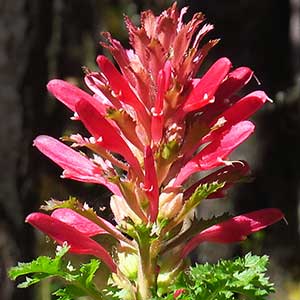Pedicularis densiflora
Pedicularis canadensis
Indian warrior, warrior's plume
beefsteak plant, Canadian lousewort, forest lousewort, pédiculaire du Canada, wood betony
basal 1–10, blade lanceolate, 30–200 x 20–70 mm, 2(or 3)-pinnatifid, margins of adjacent lobes nonoverlapping or extensively overlapping distally, 1-serrate, surfaces glabrous, hispid, or downy;
cauline 4–20, blade lanceolate, 15–250 x 5–100 mm, 2-pinnatifid, margins of adjacent lobes nonoverlapping or extensively overlapping distally, serrate, surfaces glabrous, hispid, or downy.
basal 2–20, blade lanceolate, 15–100 x 3–40 mm, 1- or 2-pinnatifid, margins of adjacent lobes nonoverlapping or slightly overlapping distally, 1- or 2-serrate, surfaces glabrous or hispid;
cauline 1–10, blade lanceolate, 10–70 x 5–20 mm, 1-pinnatifid, margins of adjacent lobes nonoverlapping or slightly overlapping distally, 1- or 2-serrate, surfaces glabrous or hispid.
simple, 1–5, exceeding basal leaves, each 10–50-flowered;
bracts lanceolate to trullate, 10–35 x 3–5 mm, undivided or 1-pinnatifid, proximal margins entire, distal 1- or 2-serrate, surfaces glabrous.
simple, 1–5, exceeding basal leaves, each 10–40-flowered;
bracts lanceolate, ovate, spatulate, or trullate, 5–40 x 1–10 mm, undivided proximally, undivided to 1-pinnatifid distally, proximal margins entire, distal 1- or 2-serrate, sometimes crenate, surfaces glabrous or hispid to tomentose.
2–4 mm.
1.5–2 mm.
calyx 9–18 mm, downy to tomentose, lobes 5, triangular, 3–4 mm, apex entire, ciliate;
corolla 23–43 mm, tube dark red, purple, or orange-yellow, rarely white, 8–18 mm;
galea dark red, purple, or orange-yellow, rarely white, 15–25 mm, beakless, margins entire medially and distally, apex straight;
abaxial lip dark red, purple, or orange-yellow, rarely white, 8–15 mm.
calyx 7–12 mm, glabrous, hispid, or tomentose, lobes 2, triangular, 0.5–2 mm, apex entire, glabrous or ciliate;
corolla 18–25 mm, tube yellow, 8–15 mm;
galea yellow, yellow with red veins, or red, sometimes purple, 10–14 mm, beakless, margins entire medially, 1-toothed distally, apex arching over abaxial lip;
abaxial lip expanded, yellow or white, 6–7 mm.
= 16.
= 16.
Pedicularis densiflora
Pedicularis canadensis
Scarlet corollas with an undomed, toothless galea and two- or three-pinnatifid leaves are diagnostic of Pedicularis densiflora. This species occurs in forested subalpine regions of southern Oregon, western slopes of the Sierra Nevada, and the Coast Ranges of California south to Baja California. Herbarium records indicate northern populations of P. densiflora occur at higher elevations than do more southern populations.
(Discussion copyrighted by Flora of North America; reprinted with permission.)
Pedicularis canadensis is chiefly of the Midwestern prairies; in eastern states and provinces, it grows in forest openings and along forest edges. It also inhabits alpine wet meadows at higher elevations along the Front Range of the Rocky Mountains. Corollas may be yellow, yellow with red veins, red (forma praeclara A. H. Moore), or bicolored with a yellow corolla tube, yellow abaxial lip, and red galea (forma bicolor Farwell).
(Discussion copyrighted by Flora of North America; reprinted with permission.)


